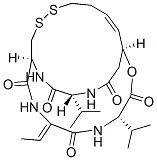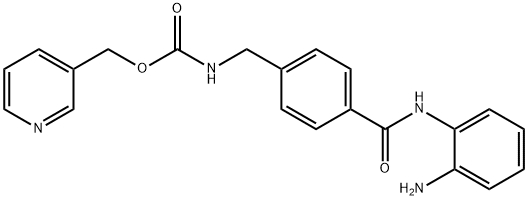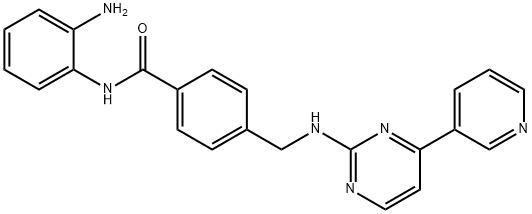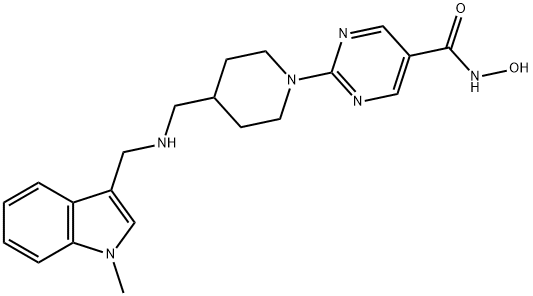Romidepsin (FK228, Depsipeptide) , ≥98% , 128517-07-7
Synonym(s):
Cyclo[(2Z)-2-amino-2-butenoyl-L-valyl-(3S,4E)-3-hydroxy-7-mercapto-4-heptenoyl-D-valyl-D-cysteinyl] cyclic (35)-disulfide;Depsipeptide;FK228;FR901228;L-Valine, N-((3S,4E)-3-hydroxy-7-mercapto-1-oxo-4-heptenyl)-D-valyl-D-cysteinyl-(2Z)-2-amino-2-butenoxyl-, (4-1)-lactone, cyclic (1-2)-disulfide
CAS NO.:128517-07-7
Empirical Formula: C24H36N4O6S2
Molecular Weight: 540.7
MDL number: MFCD18433404
| Pack Size | Price | Stock | Quantity |
| 1MG | RMB527.20 | In Stock |
|
| 5MG | RMB1839.20 | In Stock |
|
| 25mg | RMB5599.20 | In Stock |
|
| others | Enquire |
PRODUCT Properties
| Melting point: | 219-224°C |
| Boiling point: | 942.8±65.0 °C(Predicted) |
| Density | 1.174 |
| storage temp. | -20°C |
| solubility | Soluble in DMSO (up to 10 mg/ml). |
| pka | 11.33±0.60(Predicted) |
| form | powder |
| color | white to beige |
| Stability: | Stable for 2 years from date of purchase as supplied. Solutions in DMSO may be stored at -20° for up to 1 month. |
Description and Uses
The U.S. FDA approved romidepsin (also referredto as FK228) in 2009 for the treatment of cutaneous T-cell lymphoma (CTCL) for patients who received at least one systemic therapy. Romidepsin is a natural product that was first isolated from the fermentation broth of C. violaceum. Romidepsin is the second histone deacetylase (HDAC) inhibitor approved for CTCL, the other being vorinostat,whichwas approved by the FDA in 2006. Unlike vorinostat which is a pan-HDAC inhibitor, romidepsin shows modest selectivity for class I HDACs in in vitro assays. It has been shown that after romidepsin enters the cytoplasm, the disulfide bond is cleaved by glutathione to release the sulfhydryl groupwhich chelateswith the activesite zinc of class IHDACs and inhibits the enzymatic activity at nanomolar concentrations. Although romidepsin inhibits class I HDACs, it is 17–23 times less potent as the parent than the corresponding reduced form at each isozyme. For example, the IC50 of romidepsin at HDAC1 is 36±16nM while that of the reduced form is IC50=1.6± 0.9nM.Romidepsinhasalsobeenshownto induce cell cycle arrest, differentiation, and apoptosis in tumor cells by mechanisms that cannot be completely explained by HDAC inhibition alone.
Romidepsin is a histone deacetylase inhibitor that can alter chromatin structure and gene transcription leading to multiple changes in cellular protein production. This may result in cell cycle arrest and tumor growth inhibition. Romidepsin has shown anti-proliferative activity in vitro against multiple mouse and human tumor cell lines and in vivo in human tumor xenograft models. Romidepsin can be administered with a second agent, such as a cytotoxic agent, a steroidal agent, a proteasome inhibitor, or a kinase inhibitor.
Safety
| Symbol(GHS) |    GHS08,GHS09,GHS06 |
| Signal word | Danger |
| Hazard statements | H301-H341-H317-H410 |
| Precautionary statements | P201-P202-P281-P308+P313-P405-P501-P264-P270-P301+P310-P321-P330-P405-P501-P261-P272-P280-P302+P352-P333+P313-P321-P363-P501-P273-P391-P501 |
| RTECS | YV9399000 |
| HS Code | 29349990 |
| Toxicity | mouse,LD50,intraperitoneal,6400ug/kg (6.4mg/kg),Journal of Antibiotics. Vol. 47, Pg. 301, 1994. |






